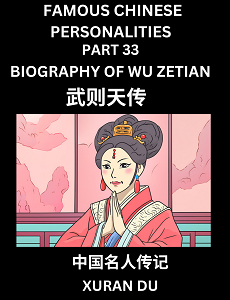Title of Biography in Chinese, Pinyin: 武则天传 (Wǔ Zétiān Zhuàn).

Title of Biography in English: The Biography of Wu Zetian.
Check out books on my Amazon and Barnes & Noble homepages as well as the following pages to learn Biographies of famous Chinese personalities-
- Part 1 – Chinese Biography Book Series for Beginners
- Part 2 – Chinese Biography Book Series for Beginners
- Part 3 – Chinese Biography Book Series for Beginners

The Biography of Wu Zetian in English (英文传记)
The Biography of Wu Zetian
Wu Zetian, a politician from the Tang to Wu Zhou dynasties, was the founder of the Wu Zhou dynasty and the only legitimate female emperor in Chinese history. She was also one of the oldest and longest-lived emperors. At the age of fourteen, she entered the imperial palace as a concubine of Emperor Taizong of the Tang Dynasty and was given the nickname “Wu Mei.” Later, she became the empress of Emperor Gaozong. After his death, she assumed power as the regent Empress Dowager of Emperor Zhongzong and Emperor Ruizong.

During her reign, Wu Zetian reformed the imperial examination system, introduced palace and martial arts examinations, rewarded agriculture and sericulture, reformed the bureaucratic system, and valued the selection of talents, leading to the emergence of many capable officials. She also attached great importance to cultural development and vigorously promoted Buddhism, making it flourish during the Tang Dynasty.
However, Wu Zetian’s reign was also controversial. To consolidate her power, she took harsh measures to suppress those who opposed her. In her later years, she also became dependent on male favorites, leading to political turmoil.
Wu Zetian passed away at the age of 82 during the Shenlong period. Emperor Zhongzong complied with her wishes and renamed her “Zetian Da Sheng Empress,” and she was buried in Qianling Mausoleum as an empress. Her life was filled with legendary colors, making her an important figure in Chinese history.
Learn Biography Of Wu Zetian in Chinese (中文传记)
武则天传
武则天,唐朝至武周时期政治家,武周开国君主,也是中国历史上唯一正统的女皇帝,即位年龄最大、寿命最长的皇帝之一。她十四岁入后宫为唐太宗才人,获赐号“武媚”,后为高宗皇后,高宗驾崩后,她作为唐中宗、唐睿宗的皇太后临朝称制。

武则天在位期间,她改革科举制度,开创殿试和武举,奖励农桑,改革吏治,知人善任,重视选拔人才,使得贤才辈出。同时,她也重视文化的发展,大力弘扬佛教,使得佛教在唐朝时期达到鼎盛。
然而,武则天的统治也伴随着一些争议。她为了巩固自己的统治,采取了严厉的手段,对反对她的人进行了残酷的打压。同时,她晚年也陷入了对男宠的依赖,导致朝政混乱。
武则天于神龙元年崩逝,享年八十二岁,中宗遵其遗命,改称“则天大圣皇后”,以皇后身份入葬乾陵。她的一生充满了传奇色彩,是中国历史上一位重要的人物。
Wu Zetian Biography Keywords- English, Chinese & Pinyin (关键词)
- 武则天 (Wǔ Zétiān): Wu Zetian: 唐朝至武周时期的女皇帝,中国历史上唯一正统的女皇帝。
- 科举制度 (Kējǔ zhìdù): Imperial Examination System: 古代中国选拔官员的制度。
- 殿试 (Diànshì): Palace Examination: 科举制度中最高级别的考试。
- 农桑 (Nóngsāng): Agriculture and Sericulture: 古代中国重要的经济支柱。
- 佛教 (Fójiào): Buddhism: 传入中国的外来宗教,对中国文化产生了深远的影响。
Pinyin of Wu Zetian Biography (武则天传记的拼音)

wǔzétiān, táng cháo zhì wǔ zhōu shíqí zhèngzhì jiā, wǔ zhōu kāiguó jūnzhǔ, yěshì zhōngguó lìshǐ shàng wéiyī zhèngtǒng de nǚ huángdì, jíwèi niánlíng zuìdà, shòumìng zuì zhǎng de huángdì zhī yī. Tā shísì suìrù hòugōng wèi táng tàizōng cái rén, huò cì hào “wǔ mèi”, hòu wèi gāo zōng huánghòu, gāozōngjià bēng hòu, tā zuòwéi tángzhōngzōng, táng ruìzōng de huáng tàihòu lín cháo chēng zhì.
Wǔzétiān zài wèi qíjiān, tā gǎigé kējǔ zhìdù, kāichuàng diànshì hé wǔ jǔ, jiǎnglì nóng sāng, gǎigé lìzhì, zhīrén shàn rèn, zhòngshì xuǎnbá réncái, shǐdé xián cái bèichū. Tóngshí, tā yě zhòngshì wénhuà de fǎ zhǎn, dàlì hóngyáng fójiào, shǐdé fójiào zài táng cháo shíqí dádào dǐngshèng.
Rán’ér, wǔzétiān de tǒngzhì yě bànsuízhe yīxiē zhēngyì. Tā wèile gǒnggù zìjǐ de tǒngzhì, cǎiqǔle yánlì de shǒuduàn, duì fǎnduì tā de rén jìnxíngle cánkù de dǎyā. Tóngshí, tā wǎnnián yě xiànrùle duì nán chǒng de yīlài, dǎozhì cháozhèng hǔnluàn.

Wǔzétiān yú shénlóng yuán nián bēng shì, xiǎngnián bāshí’èr suì, zhōng zōng zūn qí yí mìng, gǎichēng “zé tiān dà shèng huánghòu”, yǐ huánghòu shēnfèn rù zàng qián líng. Tā de yīshēng chōngmǎnle chuánqí sècǎi, shì zhōngguó lìshǐ shàng yī wèi zhòngyào de rénwù.


